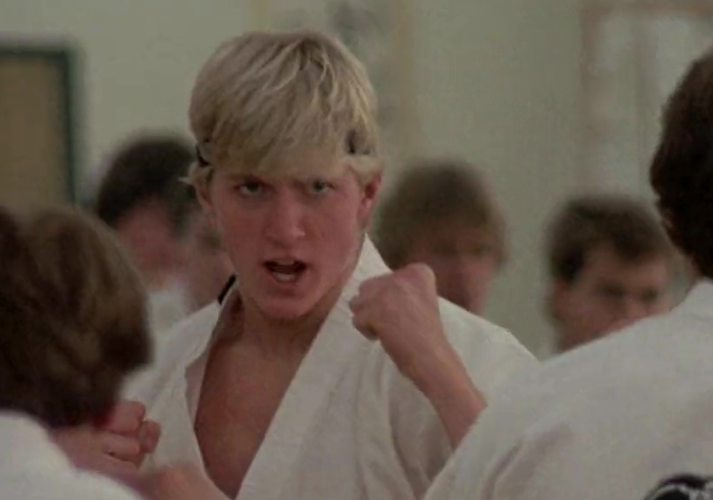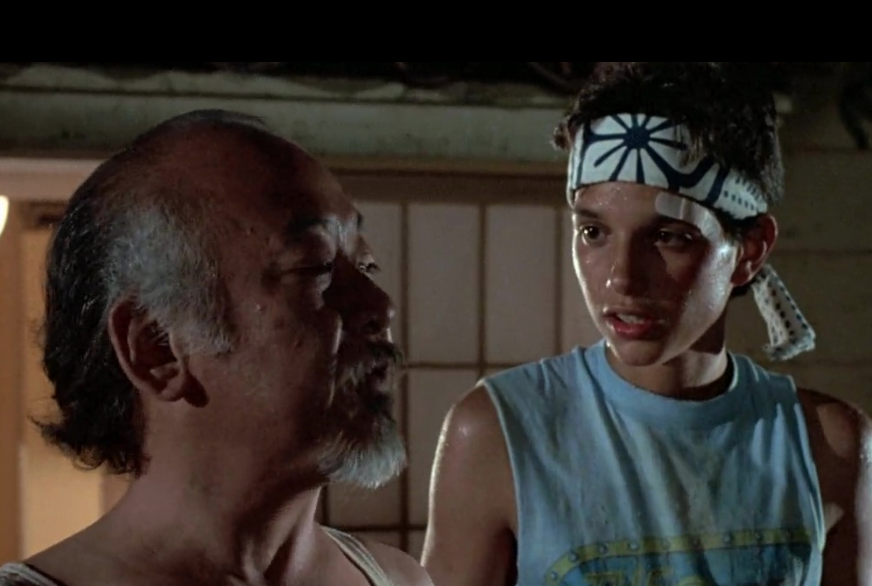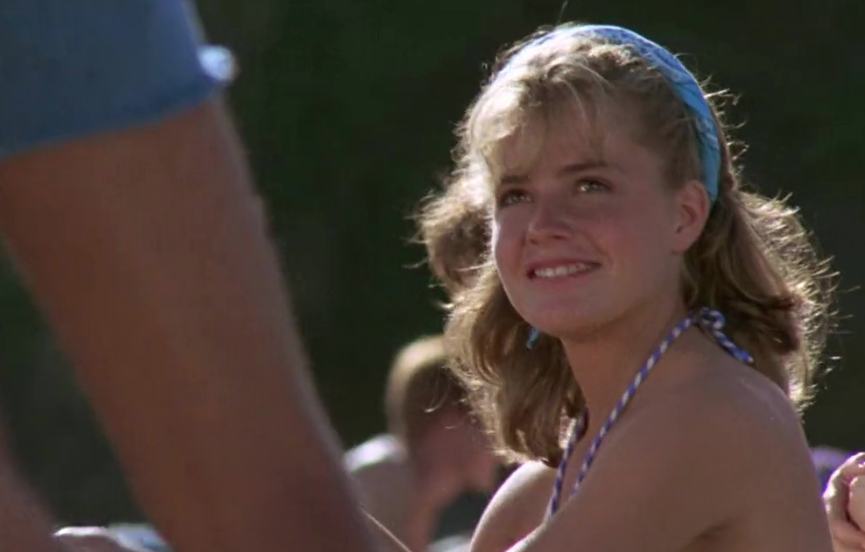That Moment In ‘The Karate Kid’ When Danny Puts It Together
The underdog story is nothing new, and The Karate Kid does not attempt to tamper with the successful formula. What it does do is make it interesting, thanks mostly to a very likable Ralph Macchio and the immeasurable presence of Pat Morita, along with some terrific moments of true inspiration.
Things go pretty much as we expect throughout the story, with Macchio’s “Daniel” struggling in a new school to make friends, getting into trouble with the school bully and hoping to get close with the pretty girl (the bully’s ex) in class. Needing to defend himself, the solitary Japanese caretaker at Daniel’s apartment complex takes him under his wing and teaches him Karate, and much, much more.
While this theme in movies grew ever more present in the decades that have followed, The Karate Kid breathes a welcome bit of life into the mix and though we could not possibly be surprised by anything in it, like watching a master at the piano playing classics, it just feels great.
John G. Avildsen had previously directed the equally formulaic but successful Rocky, and he shows the same strength in bringing all the right elements together in the hero-is-born story. Few can deny the satisfaction in watching the bad guys get their due or especially, the boy become a man. Let’s take a look.
Daniel has been struggling to understand why Mr. Miyagi refuses to outright teach him how to fight. Instead, he has been waxing cars, painting fences, and sanding floors. He’s diligent, but frustrated.
We too have been curious as to why Mr. Miyagi has put the boy to doing chores rather than go right to the training, but we suspect there is something about all that work that will pay off. Why else devote so much screen time to it? The reward is worth it. Watch Daniel’s face express petulance at first, believing he’s being tricked again, and then slowly realize what he has been doing. His eyes widen, his stance changes, and the reflexes he has been honing burst forth. Listen as a jet airplane-almost imperceptibly-takes flight in the background just as Daniel “gets it.” A wonderful audio cue.
Where to begin with this film? There are a lot of memorable scenes, some that have become iconic (you’re picturing the crane stance right now, aren’t you?). The final fight is also stirring (even if the kick is essentially illegal). We also liked some of the surprisingly touching moments as well, especially with a drunken Mr. Miyagi. We chose this scene because without it, Daniel’s evolution would feel incomplete. Sure, Mr. Miyago could have gone right to the gym with Daniel (or on the beach as the obligatory montage reveals), but this would be filler and waste the viewer’s time. In allowing the audience to experience the same frustration Daniel is feeling, we become a part of the evolution. It’s a great “ah-ha!” moment, punctuated by excellent performances. Daniel has been the gangly, awkward boy, impatient and vulnerable. And then we see the first light of hope. The arms swing knowingly, the face tightens, the posture shifts. Daniel is changing. And then, “Come back, tomorrow.” Everything about Mr. Miyagi is revealed. He is the teacher we all knew he would be.
Most of us can identify with Daniel in some way or another. That is the wonder of good characters – we project ourselves onto them. Of course, not many of us get this kind of opportunity to make such a public change and thoroughly defeat the “bad” in our lives, but the escapism of movies allows us to imagine it at least. That is surely why these underdog films remain so popular. Daniel is the everyman hero, and the scenarios he faces are metaphors for many of our own lives.

William Zabka (above) plays the bad guy. He’s too handsome, too well-built, too much everything, and because he is also obnoxious, we love to loathe him. He is the perfect bad guy (probably why he made a career of it) and is obligated to be struck down. Daniel carries our frustrations with him and does the work for us, overcoming the odds and gaining the accolades, but giving us the hope. Imagine our disappointment if he had failed. This film is not about that kind of lesson. Instead, he soars and gets everything he wanted. If only it were so in real life.

Meanwhile, Mr. Miyagi has his own demons. We may not come to know all of them; we are offered only a glimpse into his past. We see an old photo of a lovely woman as he pours two drinks. He shares a drunken (and therefore vulnerable) moment with Daniel. Wearing a WWII uniform he is obviously tortured by the internment of his family and the horrors of war. It is an all too brief look at the man so instrumental in guiding Daniel, but it does give us just enough depth to know that his new protégé is perhaps serving a much larger purpose. The Karate Kid is about redemption and growth. For everyone.
Of course, if we’re talking Miyagi, then we have to talk about the “trick”. And no, not the crane kick trick. We mean the mystical powers of his rubbing healing hands (i.e., he’s Asian). Its an old, tired trope in film and television and it reaches a zenith here as the movie is very much grounded in reality expect for this element. Certainly, there are many ancient beliefs where hands are thought to heal, but for this film, it is added specifically because he is an older Japanese man. His broken English, honorable, stoic persona, and teaching style are all contributors to the image. Still, Morita plays it well. As inconceivable as his magic is, we can believe that if anything, it works enough on the young, naive, Daniel. He believes it does, and that’s all Mr. Miyagi needs for his student to think. Us too.
Inevitably, the movie slips into some silliness. The idea that the entire dojo is against Daniel is absurd at best, and the initial confrontation between Kreese (Martin Kove) and Mr. Miyagi is suitably ridiculous in setting up the big showdown (see clip, below). It is laughably performed and too overcooked for the real tone of the film, but ultimately forgivable as we need to see that Johnny is really a bad guy pawn. He needs redemption as well. His weakness and realization are another part of the story arc and provides a little sense of hope that he’ll find his way. Who are we kidding? It’s pure 80s magic. Campy and gloriously silly.
Let’s return to where we started. Daniel learning that all his housework chores for Mr. Miyagi has purpose stands out as the heart of the film. It introduces the second half where learned lessons will come to fruition. While it might not have the mass appeal of the final battle and the training sequence, it is the most important step in establishing that the teacher/student dynamic is secure and that we as the audience will be led safely to the satisfying conclusion. There is a beautiful simplicity to the scene that lacks a few cues we generally expect. For example, let’s compare the scene with the 2010 remake with Jackie Chan and Jaden Smith:
Notice the camera. In the original it barely moves, sometimes lingering motionless for a long time, cutting to show perspective and eventually drawing in to their profiles. The remake has the camera swirling and tilting, sweeping around the players as if we are afraid to get close. More importantly, there is not one note of music in the original. The ambiance is the sound of night, creepers and crickets and that (as mentioned) soaring airplane cued just as Daniel fends off the flurry of attacks. Subtle but effective.
In the remake, the music is a cue, thumping us on the head that this is an important part, pay attention. Lastly, and this site is not in the business of condemning actors, especially children, but Jaden is all wrong. (We will forget that while the movie is called The Karate Kid, it is about Kung Fu). While Daniel learns, he is silent, never breaking away from the astonishment that we are all witnessing. The two men remain in one position, demonstrating the worth of the hard work. Smith verbally comments on the revelation, and then proceeds to counter like a professional in the overly-choreographed fight, which moves up and down the courtyard. Surely, we understand that times have changed. For one, the age of the hero drops significantly as younger and younger seems to be where the money is. But there is an art to storytelling that allows an audience to be able to learn on their own. After watching both clips, which one had the stronger impact? Which one makes you want to find out what happens next?

While none of the films in the series are masterpieces, the original still holds up well. It remains watchable and is always great for a little up-lifting. The score and music are classic 80s, and really, the whole thing is great lice of nostalgia for that time. Elizabeth Shue is perky and quintessential, dutifully being the love interest / inspiration. What teenage boy wouldn’t take a karate chop to the face for her?
After watching it again, it’s easy to see the flaws, and there’s really very little suspense now. Yet there is a charm. Macchio is actually quite good in the role and no matter how his career stalled on him, he will forever be remembered for this work. Few actors can claim their role is iconic, but Daniel on the beach, crane-stancing atop that pole is etched in all our minds. You’re thinking of it right now.
